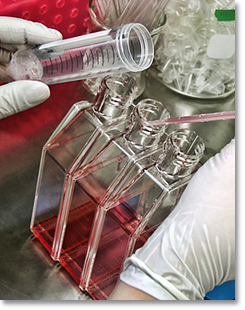EBV-specific Serodiagnostic Approaches
The current market is mostly confined to the serological diagnosis of acute mono (IM) and immune status assessment (+/- screening) to define recent or prior exposure.
In part this is due to the simplicity and low cost of current serologic testing for these purposes.
A rather limited number of routine diagnostic approaches is available for most other acute and chronic (malignant) diseases in the EBV-disease spectrum.
Recent insights at the molecular level on the pathogenic interactions of EBV and its human host have resulted in the design of new EBV-specific reagents and the development of new diagnostic approaches. This has increased the awareness on EBV-involvement in new disease entities, allowing the development of new diagnostic approaches.
There is a clear (clinical and economical) need for more frequent EBV-specific serological testing in patients with chronic fatigue and unexplained fever, which may lead to more accurate diagnosis, resulting in improved overall patient management (accurate diagnosis and appropriate treatment) and a reduction of overall healthcare costs.
Despite the increasing awareness regarding the association of EBV with the list of diseases as depicted above, current diagnostic approaches are still rather primitive.
elisa-antibody
 Heterophile Antibody testing
Heterophile Antibody testing
For diagnosis of acute IM, most laboratories worldwide still use "rapid" non-EBV specific heterophile antibody (HA) tests, which are based on the early serological work of Paul, Bunnel and Davidsohn in the 1930's. Most rapid tests (agglutination of filter assays) employ partially purified red blood cell antigens or even non-purified red cell fragments as antigen for interaction with the non-EBV specific (mostly IgM) antibodies that are produced during early stages of primary EBV-infection, probably related to the random transformation and activation of human B-cells by EBV.
Although newer HA assays show some improvement, HA-testing has limited sensitivity (80-90% of IM cases), and is not suited for diagnosis of childhood EBV-disease, nor diagnosis of chronic and malignant EBV syndromes.
Immunofluorescence testing
More recent diagnostic approaches, which are still employed widely throughout the world, are based on the pioneering EBV-specific studies of Werner and Gertrud Henle and their associates in the late 60's and 70's. They used immunofluorescence (IF) slide-testing for the detection of antibody reactivity (IgM, IgG, IgA) in human serum against complex EBV antigens expressed in various EBV-infected cell lines. Their extensive work has resulted in the elaboration of defined but complex antibody reactivity profiles that are more or less characteristic for the different EBV-associated disease syndromes.
However, standardization of IF-testing has proven rather difficult for many reasons, mostly due to the cumbersome preparation of EBV+ cell slides, the variation in various assay procedures and the subjectivity of reading of IF-test results.
ELISA testing
More recently IF-testing has been converted into EBV-specific ELISA assays that allow the detection of EBV-specific IgM, IgG and IgA responses. elisa
However due to the complex and ill defined nature of EBV-antigens involved and the difficulty of producing high quality EBV antigens in cell culture, no consensus in serological testing has been achieved yet.
There is still a clear need for improvement in EBV-specific serology testing for the diagnosis and monitoring of EBV-associated disease syndromes.
